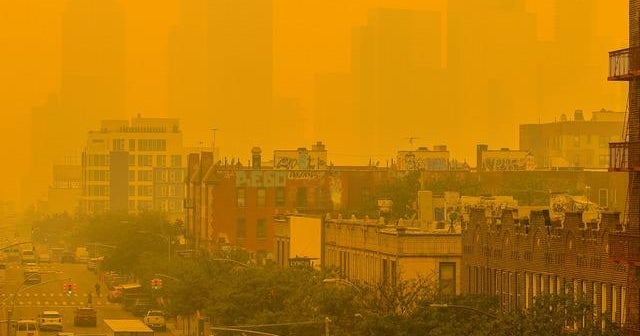Wildfires in the U.S. have caused a decline in air quality and an increase of deaths in parts of the U.S. – even though air quality had been improving, researchers say. The study used data on air pollution and related deaths in the U.S. between 2000 and 2020 and found in the wildfire-prone West, air pollution started worsening again in 2010.
Researchers looked at PM2·5 – fine inhalable particles in the air – as well as black carbon, which is emitted from coal plants, gas engines and other sources. Both decreased between 2000 and 2020, which contributed to a reduction of about 4,200 premature deaths, according to a study published in The Lancet Planetary Health.
But in 2010, the decreasing trend reversed in the Western U.S., according to the study. There was a 55% increase in PM2·5, a 86% increase in black carbon and an increase of 670 premature deaths. These large increases are attributed to wildfires, which have “become increasingly intensive and frequent in the western USA, resulting in a significant increase in smoke-related emissions in populated areas,” the researchers write.
The rest of the U.S. also saw a potential increase in the relative toxicity of PM2·5, which can cause diseases such as cancers. And 100% of populated areas in the U.S. had at least one day of excessive PM2·5 pollution – with 99% seeing seven days of poor air quality, the researchers note, and a whopping 85% seeing at least 30 days of poor air quality.
While wildfires in the West increased daily exposure risk in that area, traveling smoke also made an impact on the Midwest.
In Southern California, the increase in PM2·5 from wildfires posed a greater risk to respiratory systems than any other source of PM2·5 between 1999 and 2012, researchers say.
California saw the highest levels of air pollution, which the researchers say probably reflects the wildfire smoke patterns and dust in the state. Densely populated areas like Los Angeles, which had higher air pollution, also had higher death rates.
The researchers say an estimated 3.2 million deaths in the U.S. were attributed to PM2·5 pollution between 2000 and 2020.
In the winter and spring, PM2·5 pollution decreased across the U.S., but in the summer and autumn – wildfire season – they increased in the western U.S. while decreasing in the East. “These findings strongly suggest the potentially growing impact of wildfires on surface PM2·5 and black carbon in the western USA,” the researchers say.
In 2006 the World Health Organization’s air quality guidelines set the annual average of PM2·5 – and if it had been met in 2010, 23% of deaths could have been averted, according to the study.
The U.S. may be more affected by PM2·5 levels than more polluted countries like China and India because cleaner populations are more sensitive to PM2·5.
The majority of PM2·5-related deaths between 2006 and 2018 happened outside of the western U.S. but the studies on the impact of black carbon are lacking, researchers said. But the researchers looked at estimates of the mortalities in 66 U.S. cities attributed to long-term black carbon exposure and found that 14,000 premature deaths were caused by black carbon in 2010 alone.
Since 2000, wildfires have become larger and more frequent, according to a University of Colorado— Boulder study published in Science Advances in 2022. They have also become more widespread, burning a larger amount of area on average. The researchers warned climate change is to blame for the increasingly intense fires.
Earlier this year, several U.S. cities saw dayslong air quality alerts as wildfire smoke from blazes in Canada moved east, with the haze reaching as far as Miami and even traveling across the Atlantic to parts of Europe. Many cities saw orange and hazy colored skies as the smoke infiltrated, prompting officials to urge people to stay home and avoid the bad air, saying it could be hard to breath, especially for those with health issues.
So far in 2023, there have been 53,685 wildfires in the U.S. that have burned 2,605,339 acres, according to the National Interagency Fire Center. In California, there have been 6,935 wildfires so far this year, according to Cal Fire.



